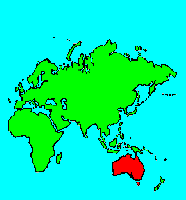SPECIES INFO
The Kagu (Rhynochetos jubatus) is found only on New Caledonia. New Caledonia is an island located hundreds of miles east of north central Australia. This is a very unique species that runs from trouble, as opposed to flying.
The orange-red legs and reddish bill will help identify this crested gray bird. The wings when spread show black and white barring. When perched the breast is paler than the dorsal grey wings. The drawing on page 112 of the Austin Birds of the World book shows a blue colored bird with a slightly darker blue head, crest, and wings. The blue crest is shown with several (perhaps 8-10) quite long feathers.The crest can lay on the back of the neck, or can be erected.
There are no subspecies.
Per Birdwatch in 2011 this species is endangered. They note that less than 1,000 individuals are known, and the population count could be as low as just 250 individuals. However, they note the population is stable. The threats are predators, habitat damage, mining, and deforestation. These birds live and nest on the ground, and the flightless Kagu is an easy prey to stray dogs. .
The introduction of cats and dogs to New Caledonia will probably soon force the end of its wild populations.The kagu of New Caledonia is a very unique bird and it is given its on family.
Cranes and Rails (Order Gruiformes) are a worldwide group of 199 species, some of which have recently become extinct. They are medium to large in size and usually associated with water. Several species have long legs and/or long necks.
Aves contains about 8,650 different species of living birds known to science. Each year about one new species is discovered in some remote rain forest or remote island. In addition, scientists have been raising many subspecies to full species status which may raise the species count to 10,000. Birdlife recognizes 10,027 species as of 2011.
However, each year about one species goes extinct. The rate of extinction is increasing, and the rate of new discovery is decreasing, so that the number of bird species will soon begin to decline rapidly. Although different taxonomists would organize the birds differently, there are approximately twenty-seven orders of birds. These orders are broken down into about one hundred and fifty-five different families.
Recent research of the genetic structure of some of the shore birds and owls would indicate that the present organization of orders and families should have some modification.
The birds are a worldwide group of animals that are characterized by having the front limbs modified into wings that are used for flying. Perhaps the most unique feature of the birds is the feathers. These feathers are made up of a central support called a quill and a series of small filaments that are hooked together as barbs.
For many years it was believed that Archaeopteryx discovered in Bavaria was the oldest bird from about 150 million years ago. However, in l986, Sankar Chattterjee, a Texas paleontologist, reportedly discovered a bird in the genus Protoavis that lived about 225 million years ago.
When this project was begun in 1978, we used Austin & Singer for bird taxonomy. Since then, we have adopted many changes, but have kept some older concepts that are still found widely in the literature. Recently, we have used Clements and Howard & Moore. Very recently, we have used Monroe and Sibley for the higher taxonomy of the perching birds.
Backboned Animals (Phylum Chordata) are the most advanced group of animals on earth. These animals are characterized by having a spinal cord or backbone. Most members have a clearly defined brain that controls the organism through a spinal cord. Fish, amphibians, reptiles, birds, and mammals are in this phylum.
Currently, some taxonomists believe that the fish should be divided into two groups (sharks and regular fishes) and that there are some other primitive groups in the phylum such as hagfish or lampreys.
Animal Kingdom contains numerous organisms that feed on other animals or plants. Included in the animal kingdom are the lower marine invertebrates such as sponges and corals, the jointed legged animals such as insects and spiders, and the backboned animals such as fish, amphibians, reptiles, birds, and mammals.

